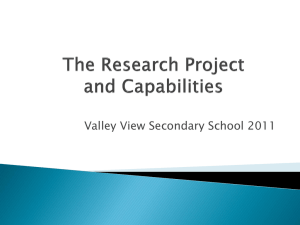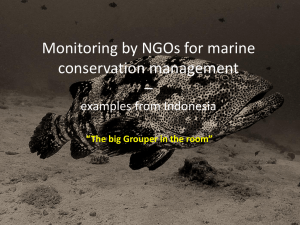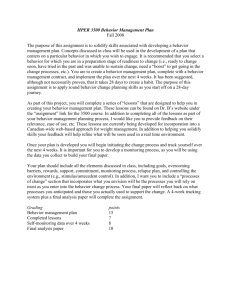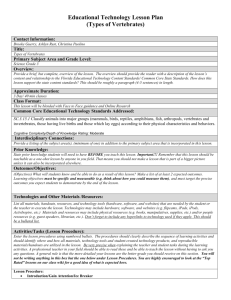the level of knowledge in the value relevance literature
advertisement
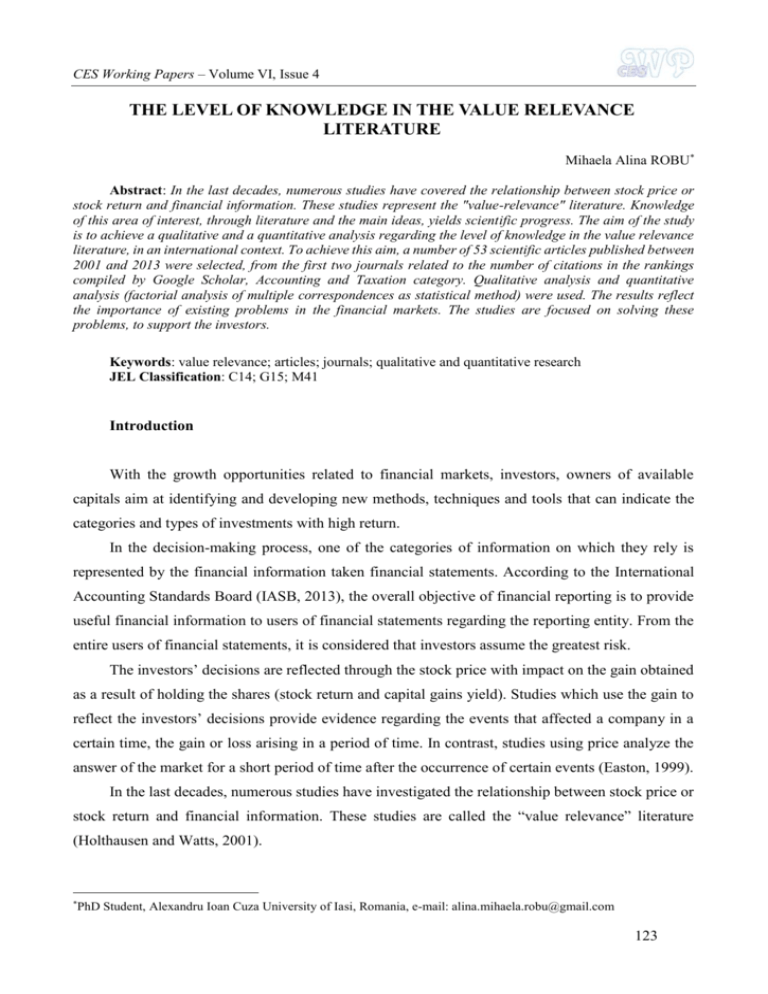
CES Working Papers – Volume VI, Issue 4 THE LEVEL OF KNOWLEDGE IN THE VALUE RELEVANCE LITERATURE Mihaela Alina ROBU* Abstract: In the last decades, numerous studies have covered the relationship between stock price or stock return and financial information. These studies represent the "value-relevance" literature. Knowledge of this area of interest, through literature and the main ideas, yields scientific progress. The aim of the study is to achieve a qualitative and a quantitative analysis regarding the level of knowledge in the value relevance literature, in an international context. To achieve this aim, a number of 53 scientific articles published between 2001 and 2013 were selected, from the first two journals related to the number of citations in the rankings compiled by Google Scholar, Accounting and Taxation category. Qualitative analysis and quantitative analysis (factorial analysis of multiple correspondences as statistical method) were used. The results reflect the importance of existing problems in the financial markets. The studies are focused on solving these problems, to support the investors. Keywords: value relevance; articles; journals; qualitative and quantitative research JEL Classification: C14; G15; M41 Introduction With the growth opportunities related to financial markets, investors, owners of available capitals aim at identifying and developing new methods, techniques and tools that can indicate the categories and types of investments with high return. In the decision-making process, one of the categories of information on which they rely is represented by the financial information taken financial statements. According to the International Accounting Standards Board (IASB, 2013), the overall objective of financial reporting is to provide useful financial information to users of financial statements regarding the reporting entity. From the entire users of financial statements, it is considered that investors assume the greatest risk. The investors’ decisions are reflected through the stock price with impact on the gain obtained as a result of holding the shares (stock return and capital gains yield). Studies which use the gain to reflect the investors’ decisions provide evidence regarding the events that affected a company in a certain time, the gain or loss arising in a period of time. In contrast, studies using price analyze the answer of the market for a short period of time after the occurrence of certain events (Easton, 1999). In the last decades, numerous studies have investigated the relationship between stock price or stock return and financial information. These studies are called the “value relevance” literature (Holthausen and Watts, 2001). * PhD Student, Alexandru Ioan Cuza University of Iasi, Romania, e-mail: alina.mihaela.robu@gmail.com 123 Mihaela Alina ROBU The objective of this study regards achieving a qualitative and quantitative analysis of the level of knowledge in the value relevance literature, in an international context. To achieve this goal a number of 53 scientific publications related to the first two journals was selected. These journals were selected according to the number of citations, from the ranking carried out by Google Scholar, category Accounting and Taxation. 1. Literature review The value relevance of financial information was one of the subjects of interest in international studies. First of all, this was due to the importance of information from financial statements (annual or interim) in making investment decisions. Barth et al. (2001) and Beisland (2009) define the concept of value relevance of financial information as the association between it and market information. This association is seen by ElSayed Ebaid (2012) through the characteristic of financial information to influence the decision making process of investors, reflected in the stock price or stock return. From the point of view of international regulation, the concept of value relevance is not explicitly recognized by standardization bodies. In both recognized international standards (IFRS and US GAAP), the conceptual framework presents relevance as a fundamental qualitative characteristic of the information presented in the financial statements, together with reliability (El-Sayed Ebaid, 2012; IASB, 2013). While financial information is considered relevant if they have the ability to generate a difference in the decisions made by users, reliability of the information refers to the faithful representation of those phenomena that it aims to represent (Barth et al., 2001 IASB, 2013). Barth et al. (2001) identifies a link between the concept of value relevance and the two fundamental qualitative characteristics of financial information. The concept of value relevance is actually a test used to verify the existence of these qualitative characteristics in the information presented in the financial statements. Thus, it is considered that the financial information is value relevant only if it is relevant by investors to assess a company and it faithfully represents the reality to be reflected in the stock price. While analyzing a series of studies regarding the value relevance of information provided by financial statements, Holthausen and Watts (2001) performed their classification considering the issues investigated. The first category is called relative association studies, testing the existence of any link between the information provided by the stock price or stock return and financial 124 THE LEVEL OF KNOWLEDGE IN THE VALUE RELEVANCE LITERATURE information. This study examines whether financial results under certain standards or accounting regulations have a high association with market values than using other accounting standards. The second category of studies, which Holthausen and Watts (2001) refers to is represented by incremental association studies. These studies examine whether the financial information of interest is useful to explain the stock price or stock return. The last category of studies analyzed by Holthausen and Watts (2001) refers to marginal information content studies, which examines whether specific information added to the one available is considered value relevant. These studies primarily use event analysis. If stock price changes significantly in the near future or after the occurrence of the event, then that event send new information on how to obtain future cash flows (Kothari, 2001). Although studies regarding the value relevance of financial information focused on identifying those significant factors for the decisions making process (book value of equity, earnings, cash flow, different financial ratios – Return on equity, Return on assets, Return on investments, etc.) with the development of international regulation, empirical research has focused on specific areas such as value pension funds, R&D, voluntary and mandatory disclosure, IFRS and US GAAP, audit report. From the point of view of Romanian literature, topics of interest regarding the value relevance of financial information took the form of empirical studies such incremental association studies, analyzing the relationship between stock price or stock return and financial information (Filip and Raffournier, 2010; Tudor, 2012; Jaba et al., 2013; Robu M.A. and Robu I.B., 2014a) or relative association studies, analyzing whether the adoption of International Financial Reporting Standards provide investors with more value relevant information (Robu M.A. and Robu I.B., 2014b). The knowledge and the profound study of the value relevance of financial information through theoretical and methodological approaches (factors, measurement and methods of valuation, financial market implications) can lead to new research directions. The existing studies focused on developed countries can represent a real support for the analysis of this issue in the emerging countries, representing a real support for investors and for the accounting convergence process. 2. Research methodology Starting from the literature corresponding to the value relevance of financial information, the article comes to conduct an exploratory analysis of the main issues in this field, in order to identify the determining factors, which stood at the base of the emergence of the analyzed studies. The exploratory analysis also supports the identification of a research trend regarding the value relevance 125 Mihaela Alina ROBU concept and of some insufficiently approached research directions. These studies which were made at an international level through the eye of reasoning, the methodology and the results represent a starting point for the case of Romania. As a working hypothesis, the study aims to obtain a profile of the level of scientific knowledge for the value relevance field, based on the interaction between determinant factors which have been identified. 2.1. Target population and analyzed sample Sample population is represented by all the studies whose main research subject is the value relevance of financial information. From their entirety, a sample of 53 studies conducted between 2001 and 2013 was selected according to the principle of the rational choice (Jaba, 2002) from Journal of Accounting and Economics – JAE and The Accounting Review – AR. The two journals were chosen after having consulted the ranking carried out by Google Scholar. During the performance of the investigation, the aforementioned journals were the first two regarding the number of citations, in the fields of Accounting & Taxation. While the articles in Journal of Accounting and Economics were selected from the ScienceDirect database, the articles in The Accounting Review were selected from the American Accounting Association website. In order to choose the articles, the keywords value relevance, financial statements and financial markets were considered. The choice of 2001 as a reference year concurs with the emergence of the first financial scandals (Enron in 2001), events that called in question the accuracy and the veracity of the information in financial statements for investors. Also, the International Accounting Standards Board – IASB replaced the International Accounting Standards Commitee – IASC in 2001. 2.2. Analyzed variables and data source In order to reach the results, the variables considered in the analysis are: Author (helps at the identification of the article); Year (shows the year the article was published and has values from 2001 to 2013); Journal (shows the journal the article was published in and has the JAE and AR values); Study type (indicates the study type: literature review – LR, critical study – CS and empirical study – ES); 126 THE LEVEL OF KNOWLEDGE IN THE VALUE RELEVANCE LITERATURE HW_study_type (indicates the study type according to the classification of Holthausen and Watts (2001): relative association study – RAS, incremental association study –IAS and marginal information content study – MICS). Data analysis has been performed using SPSS 20.0 statistical software. 2.3. Data analysis method The development of this study started from the papers of Jaba and Morosanu (2001) and Robu (2012), respectively. Through a qualitative analysis, the principal research topics in the value relevance literature were identified. Subsequently, through a quantitative analysis, using multiple factorial correspondence analysis (MFCA) the trends in value relevance literature were identified. In this study, MCFA is used to shape the trend of the research regarding the influence of the financial information on the stock price or stock return. MFCA has been developed by Jean-Paul Benzécri in the 1960’s. MFCA comes to study the relations, associations between at least three categorical or nominal variables (Lebart et al., 2006). Considering a sample of n individuals with the data corresponding to m variables, each variable being representing by at least two categories, the use of MFCA determines the profile of one individual depending on the existing associations between the considered variables (Mironiuc and Robu, 2011). MFCA is considered a mapping method that performs data reduction, filters data set and performs association between variables. 3. Results and discussions The first results reached through data processing describe the descriptive analysis through the issuance frequency of the articles, depending on the year of issuance and the study type. The issuance frequencies thus emphasize, on the one side, the predilection for value relevance topic in the considered period, and, on other side, the preference for a series of studies. Through the structuring of the sample depending on the year of issuance of the studies, Table 1 displays the periods that were seen as representative and which reflect the researchers’ interest regarding the value relevance of the financial information. 127 Mihaela Alina ROBU Table 1 – The structure of the sample depending on the articles issuance year Year of issuance Absolute frequencies 2001 2002 2003 2004 2005 2006 2007 2008 2010 2011 2012 2013 Total 4 6 7 3 6 3 8 3 3 3 4 3 53 Percentage frequencies 7.50 11.30 13.20 5.70 11.30 5.70 15.10 5.70 5.70 5.70 7.50 5.70 100.00 Cumulated percentage frequencies 7.50 18.90 32.10 37.70 49.10 54.70 69.80 75.50 81.10 86.80 94.30 100.00 Source: Own processing According to the results, the first period of interest for the analysis of value relevance literature is represented by the 2002-2003 period, when 24.50% of the studies within the sample were issued. The interest of the period in the analyzed issue is caused by the emergence of financial scandals, with a significant influence on financial statements, on investors and their trust in the financial information. 2001 also represents the first year of activity of IASB. The second important period with influence on the studies regarding the relevance of the financial-accounting information is 2005-2007, when 32.10% of the articles in the sample were published. The interest in this period is caused by the mandatory use of the IFRS in the issuance of the consolidated financial statements starting with the 2005 financial exercise, by companies listed on the stock exchanges in the European Union. The Securities and exchange Commission – SEC has also started accepting financial statements issued according to the IFRS in 2007, without reconciling the results or the owners’ equities. The following periods are characterized by an approximately constant interest for this topic. As for the structuring of the sample depending the article type, we can see from Table 2 the preference for the empirical articles (81.10%) to the prejudice of the ones regarding the literature review (7.60%) or the critical ones (11.30%). 128 THE LEVEL OF KNOWLEDGE IN THE VALUE RELEVANCE LITERATURE Table 2 – Sample structure depending on the study type Study type Literature review studies (LR) Empirical studies (ES) Critical studies (CS) Total Absolute frequencies 4 43 6 53 Percentage frequencies 7.60 81.10 11.30 100.00 Cumulated percentage frequencies 7.60 88.70 100.00 Source: Own processing The low number of studies regarding the literature review (4 articles) is caused by the time that has passed from the issuance of the first studies regarding the influence of the financial information on stock price or stock return (1968) until the reference year of the study (2001), when the theoretical and methodological concept regarding the value relevance have been frequently approached and explicated. Thus, researchers do not rely on displaying the literature review any more, which can be found in a significant number of articles in the early 1990’s. As a result, empirical studies are the ones that gain ground, as a consequence of the advantages that can be gained from them: the identification of the best accounting method amongst the alternative ones, the identification of the most revealing standards from the investors’ point of view, the development of models designed to test the value relevance of financial information. According to Figure 1, considering the year of issuance of the studies in the sample and the study type, we can notice that studies regarding the literature review are dated especially in 2001, at the beginning of the analysis period, the interest regarding the critical studies being more frequent in 2005 and 2008 and the empirical studies have represented the main research type lately. Although the complexity of the studied phenomenon has amplified, optimizing the research methods, the statistical instruments and the information data bases development have boosted the development of empirical studies. Figure 1 - The distribution of the considered study types from 2001-2013 Source: Own processing 129 Mihaela Alina ROBU According to Holthausen and Watts (2001), another study classification from the sample was made, in relative association studies (RAS), incremental association studies – (IAS) and marginal information content study (MICS). Those studies whose objectives were literature reviews, critical studies and the studies that cannot be classified in any of Holthausen and Watts’s (2001) categories (for example, empirical studies where the relevance of the financial-accounting information is an independent variable) were excluded from the sample. The resulted sample will thus include a number of 41 studies. The sample structure is presented in Table 3. Table 3 –Sample structure depending on the study type according to Holthausen and Watts’s classification (2001) Absolute Percentage Cumulated percentage Study type frequencies frequencies frequencies Relative association studies (RAS) 9 22.00 22.00 Incremental association studies (IAS) 19 46.30 68.30 Marginal information content study 13 31.70 100.0 (MICS) Total 41 100.0 Source: Own processing According to Table 4, it can be seen that most empirical studies from this period (46.30%) consider the incremental associations regarding the influence of the financial information on the stock price or stock return, as a result of the need to identify the financial information that is relevant to investors when making decisions. The ease they can be applied is an advantage of these studies. Studies regarding marginal information represent 31.70% of the empirical studies sample and are mainly based on the analysis of the events, on identifying the influence of certain events, such as communicating the results to the participants on the capital market or the communication of relative information to the dividends’ distribution. Studies regarding the relative association only represent 22.00% of the whole sample and reflect the extent to which financial results, gained according to the regulations in a certain financial reporting standards, display an association degree to the market values that is higher than the one gained by using another financial reporting standards. Within this study type, most analyses consider comparisons between the IFRS and the US GAAP. Starting from Holthausen and Watts’s (2001) classification, Figure 2 displays the association degree between the variable that indicates this classification and the Year variable. 130 THE LEVEL OF KNOWLEDGE IN THE VALUE RELEVANCE LITERATURE Figure 2 – The distribution of the considered studies types according to Holthausen and Watts’s (2001) classification between 2001 and 2013 Source: Own processing According to the figure, the results show that that the studies regarding the marginal information content based on the event analysis can be found especially in 2002 and 2005. Studies regarding incremental associations are frequent mostly in 2002, 2003 and 2007. This situation emphasizes the need to identify the financial information in any period, which can be considered relevant to investors. The multitude of factors that change permanently and which influence the market profitableness or the share price determines the existence of studies regarding incremental associations. Many of these studies (Chen et al., 2002; Hanlon et al., 2003; Kallapur and Kwan, 2004) start from the Ohlson (1995) model. The nearness of the 2002 and 2003 financial exercises indicates the need, in that period, marked by financial scandals regarding frauds, to identify relevant financial information that investors can count on. In the case of the studies within the sample, the most important factors, through the eye of the influence they have on the market stock return or stock price are the information included in the profit and loss account – the earnings per share (Kothari and Shanken, 2001; Subramanyam and Venkatachalam, 2007); information that is specific to the balance sheet – the accounting value per share (Chen et al., 2002; Core et al., 2003) the research and development expenditures (Core et al., 2003; Kimbrough, 2007; Ciftci and Cready, 2011); information specific to cash flows – cash flows from the operating provisions (Subramanyam and Venkatachalam, 2007; Kumar and Krishnan, 2008; Jones and Smith, 2011); factors regarding the corporate governance (Larcker et al., 2007). From the point of view of the studies regarding the relative association analysis, Figure 2 shows the presence during the last years of a trend regarding the comparisons between the relevance of the financial information obtained according to a financial reporting standard and the relevance of the 131 Mihaela Alina ROBU information obtained by applying another financial reporting standard (Lang et al., 2006; Song et al., 2010; Barth et al., 2012). This is also supported by the growth of the number of countries where the IFRS are used and also the significant efforts regarding the diminishing of the differences between the main international standards. From the point of view of the method that was used in the analyzed studies, in most of them, the multiple linear regression analysis is used, thus analyzing on one side, the coefficients corresponding to the analyzed factors, and on the other side, the value of the coefficient of determination. Yet, Fan and Wong (2002), Kallapur and Kwan (2004) and Kimbrough (2007) use the panel analysis to identify the existing link between certain factors and the stock return. Moreover, Altamuro et al. (2005) uses ANOVA to test the differences between two categories of companies, before and after the use of financial reporting standards. From all the authors of the analyzed articles, Mary Barth represents the author with most of the articles, from this period, regarding the value relevance of financial information. Her studies are mainly based on differences between the main financial reporting standards, thus giving perspectives in the standards’ regulation and improvement process. Conclusions Regarded as a problem of interest in the field of accounting and financial markets, value relevance concept raised the research interests, reflected by the number of studies published in journals recognized, and not only, but also by identifying, continuously, new research directions. The need for scientific progress is based primarily on the knowledge the domain of interest, through literature and through the main ideas related to research. This knowledge will then determine the emergence of new ideas materialized through empirical, critical or literature review studies. The results of this study reflect a continuing concern of research on the value relevance topic and, especially, of the empirical studies to the detriment of critical or literature review studies. This is due mainly to establish a conceptual framework with the emergence of the concept of value relevance. To assist investors, empirical studies have always sought new information which may be based in decision making process. As a consequence, the number of empirical studies regarding the significantly information with impact on the stock price or stock return has increased. Globalization and the adoption of international accounting standards or new accounting regulations have led to relative association studies to identify the most relevant information provided by existing accounting rules. 132 THE LEVEL OF KNOWLEDGE IN THE VALUE RELEVANCE LITERATURE Presenting the main research direction in the last decade, through statistical methods, though it has some limitations determined by the complexity of the issue regarding the relevance of the financial information, as well as by the impossibility to surprise all factors that have influence on the relevance and all discussion themes existing in the literature. This last limit is caused by the method of developing the sample, using only two reference journals. Choosing the journals also determines, in return, the impossibility to know the research directions regarding the emerging countries, such as Romania. Being two top journals, it is mainly based on the issue of the relevance of the financial information in states such as the USA or the United Kingdom. Yet, future directions in the case of Romania aim at approaching the similar subjects to the international ones, and, due to the fact that Romanian companies are mandated to use the IFRS starting with the 2012 financial exercise, if their securities are admitted for trading on a regulated market. Acknowledgement This work was cofinanced from the European Social Fund through Sectoral Operational Programme Human Resources Development 2007-2013, project number POSDRU/159/1.5/S/142115 „Performance and excellence in doctoral and postdoctoral research in Romanian economics science domain”. References Altamuro, J., Beatty, A. L. and Weber, J. (2005), "The Effects of Accelerated Revenue Recognition on Earnings Management and Earnings", The Accounting Review, Vol. 80, No. 2, pp. 373-401. Barth, M. E., Beaver, W. H. and Landsman, W. R. (2001), "The relevance of the value-relevance literature for financial accounting standard setting: another view", Journal of Accounting and Economics, Vol. 31, No. 1, pp. 77-104. Barth, M. E., Landsman, E. R. Lang, M. and Williams, C. (2012), "Are IFRS-based and US GAAPbased accounting amounts comparable?", Journal of Accounting and Economics, Vol. 54, Issue 1, pp. 68-93. Beisland, L. A. (2009), "A Review of the Value Relevance Literature", The Open Business Journal, 2009, Vol. 2, pp. 7-27. 133 Mihaela Alina ROBU Chen, S., DeFond, M. L. and Park, C. W. (2002), "Voluntary disclosure of balance sheet information in quaterly earnings announcements", Journal of Accounting and Economics, Vol. 33, Issue 2, pp. 229-251. Ciftci, M. and Cready, W. M. (2011), "Scale effects of R&D as reflected in earnings and return", Journal of Accounting and Economics, Vol. 52, Issue 1, pp. 62-80. Core, J. E., Guay, W. R. and Van Buskirk, A. (2003), "Market valuations in the New Economy: an investigation of what has changed", Journal of Accounting and Economics, Vol. 34, Issues 13, pp. 43-67. Easton, P. D. (1999), "Security Returns and the Value Relevance of Accounting Data", American Accounting Association, Vol. 13, No. 4, pp. 399-412. El-Sayed Ebaid, I. (2012), "The value relevance of accounting-based performance measures in emerging economies. The case of Egypt", Management Research Review, Vol. 35, No. 1, pp. 69-88. Fan, J. P. H. and Wong, T. J. (2002), "Corporate ownership structure and the informativeness of accounting earnings in East Asia", Journal of Accounting and Economics, Vol. 33, Isuue 3, pp. 401-425. Filip A. and Raffournier B. (2010), "The value relevance of earnings in a transition economy: The case of Romania", The International Journey of Accounting, Vol. 45, Issue 1, pp. 77-103. Hanlon, M., Myers, J. N. and Shevlin, T. (2003), "Dividend taxes and firm valuation: a reexamination", Journal of Accounting and Economics, Vol. 35, Issue 2, pp. 119-153. Holthausen, R. W. and Watts, R. L. (2001), "The relevance of the value-relevance literature for financial accounting standard setting", Journal of Accounting and Economics, Vol. 31, No. 13, pp. 3-75. International Accounting Standards Board (2013), International Financial Reporting Standards, Sixth Edition Revised, CECCAR , Bucuresti. Jaba, E. and Morosanu, A. (2011), "Identificarea statistica a tendintelor menifestate in cercetarea caracteristiilor operatorului de sondaj", Revista romana de statistica, No. 12, pp. 35-46. Jaba, E. (2002), Statistica, 3rd Edition, Editura Economica, Bucuresti. Jaba, E., Mironiuc, M., Roman, M., Robu, I.-B. and Robu, M.-A. (2013), "The Statistical Assessment of an Emerging Capital Market Using the Panel Data Analysis of the Financial Information", Economic Computation and Economic Cybernetics Studies and Research, Vol. 47, No. 2, pp 21-36. 134 THE LEVEL OF KNOWLEDGE IN THE VALUE RELEVANCE LITERATURE Jones, D. A. and Smith, K. J. (2011), "Comparing the Value Relevance, Predictive Value, and Persistence of other Comprehensive Income and Special Items", The Accouting Review, Vol. 86, No. 6, pp. 2047-2073. Kallapur, S. and Kwan, S. Y. S. (2004), "The Value Relevance and reliability of brand Assets Recognized by U.K. Firms", The Accounting Review, Vol. 79, No. 1, pp. 151-172. Kimbrough, M. D. (2007), "The Influences of Financial Statement Recognition and Analysr Coverage on the Market’s Valuation of R&D Capital", The Accounting Review, Vol. 82, No. 5, pp. 11951225. Kothari, S. P. (2001), "Capital markets research in accounting", Journal of Accounting and Economics, Vol. 31, Issues 1-3, pp. 105-231. Kumar, K. R. and Krishnan, G. V. (2008), "The Value-Relevance of Cash Flows and Accruals> The Role of Investement Opportunities", The Accounting Review, Vol. 83, No. 4, pp. 997-1040. Lang, M., Raedy, J. S. and Wilson, W. (2006), "Earnings management and cross listing: Are reconciled earnings comparable to US earnings? ", Journal of Accounting and Economics, Vol. 42, Issues 1-2, pp. 255-283. Lebart, L., Piron, M. and Morineau, A. (2006), Statistique exploratoire multidimensionnelle. Visualisation et inférences en fouille de données, 4e Édition, Dunod, Paris. Ohlson, J. A. (1995), "Earnings, Book Values, and Dividends in Equity Valuation", Contemporary Accounting Research, Vol. 11, No. 2, pp. 661-687. Robu, I.-B. (2012), "Studiu explorator al cunoasterii problematicii fraudei financiare din perspective auditului financiar", Revista Audit Financiar, Year X, No. 96 – 12, pp. 8-16. Robu, M.-A. and Robu, I.-B. (2014a), "The Influence of the Principal Dimensions of Accounting Information on the Capital Gains Yield in the Case of Romanian Listed Companies", ProcediaSocial and Behavioral Sciences, Vol. 143, No. 14, pp. 985-989. Robu, M.-A. and Robu, I.-B. (2014b), "Analiza perceptiei investitorilor privind informatiile raportate de firmele romanesti cotate la bursa inainte si dupa aplicarea IFRS", Revista Audit Financiar, Year XII, No. 119 – 11, pp. 37-42. Song, C. J. And Thomas, W. B.Yi, H. (2010), "Value Relevance of FAS No. 157 Fair Value Hierarchy Information and the Impact of Corporate Governance Mechanisms", The Accounting Review, Vol. 85, No. 4, pp. 1375-1410. Subramanyam, K. R. and Venkatachalam, M. (2007), "Earnings, Cash Flows, and Ex Post Intrinsic Value of Equity", The Accounting Review, Vol. 82, No. 2, pp. 457-481. 135 Mihaela Alina ROBU Tudor, C. (2012), "Information asymmetry and risk factors for stock returns in a post-communist transition economy: Empirical proof of the inefficiency of the Romanian stock market", African Journal of Business Management, Vol. 6, No. 16, pp. 5648-5656. 136


